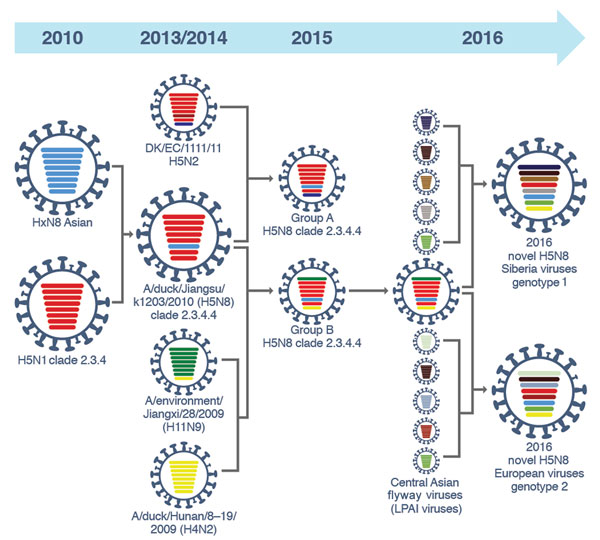Genesis of Influenza A(H5N8) Viruses
Rabeh El-Shesheny, Subrata Barman, Mohammed M. Feeroz, M. Kamrul Hasan, Lisa Jones-Engel, John Franks, Jasmine Turner, Patrick Seiler, David Walker, Kimberly Friedman, Lisa Kercher, Sajeda Begum, Sharmin Akhtar, Ashis Kumar Datta, Scott Krauss, Ghazi Kayali, Pamela McKenzie, Richard Webby, and Robert G. Webster

Author affiliations: National Research Centre, Giza, Egypt (R. El-Shesheny); St. Jude Children’s Research Hospital, Memphis, Tennessee, USA (R. El-Shesheny, S. Barman, J. Franks, J. Turner, P. Seiler, D. Walker, K. Friedman, L. Kercher, S. Krauss, P. McKenzie, R.J. Webby, R.G. Webster); Jahangirnagar University, Savar, Dhaka, Bangladesh (M.M. Feeroz, M.K. Hasan, S. Begum, S. Akhtar, A.K. Datta); University of Washington, Seattle, Washington, USA (L. Jones-Engel); University of Texas Health Sciences Center, Houston, Texas, USA (G. Kayali); Human Link, Hazmieh, Lebanon (G. Kayali)
Main Article
Figure 2

Figure 2. Illustration of original reassortment events of novel highly pathogenic avian influenza (HPAI) A(H5N8) viruses isolated from Siberia and Europe in 2016. The 8 gene segments (from top to bottom) in each virus are polymerase basic 2, polymerase basic 1, polymerase acidic, hemagglutinin, nucleoprotein, neuraminidase, matrix, and nonstructural. Each color indicates a separate virus background. In 2010, HPAI A(H5N1) clade 2.3.4 viruses reassorted with subtype N8 viruses from Eurasia and produced A/duck/Jiangsu/k1203/2010(H5N8). Until late 2013, HPAI viruses with H5N8 subtypes circulated in eastern China and South Korea. In 2014, HPAI A(H5N8) viruses reassorted with A/duck/Hunan/8–19/2009(H4N2) and A/environment/Jiangxi/28/2009(H11N9) to generate group B viruses. The subsequent reassortment between HPAI A(H5N8) group B viruses and low pathogenicity (LPAI) viruses circulating along the central Asian flyway led to generation of the novel HPAI A(H5N8) genotype 1 and 2 viruses.
Main Article
Page created: July 17, 2017
Page updated: July 17, 2017
Page reviewed: July 17, 2017
The conclusions, findings, and opinions expressed by authors contributing to this journal do not necessarily reflect the official position of the U.S. Department of Health and Human Services, the Public Health Service, the Centers for Disease Control and Prevention, or the authors' affiliated institutions. Use of trade names is for identification only and does not imply endorsement by any of the groups named above.
